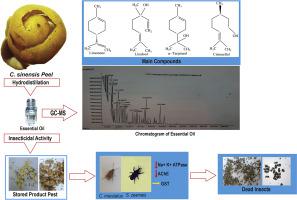当前位置:
X-MOL 学术
›
Pestic. Biochem. Phys.
›
论文详情
Our official English website, www.x-mol.net, welcomes your
feedback! (Note: you will need to create a separate account there.)
Insecticidal and biochemical activity of essential oil from Citrus sinensis peel and constituents on Callosobrunchus maculatus and Sitophilus zeamais
Pesticide Biochemistry and Physiology ( IF 4.2 ) Pub Date : 2020-09-01 , DOI: 10.1016/j.pestbp.2020.104643 A O Oyedeji 1 , W O Okunowo 1 , A A Osuntoki 1 , T B Olabode 1 , F Ayo-Folorunso 1
Pesticide Biochemistry and Physiology ( IF 4.2 ) Pub Date : 2020-09-01 , DOI: 10.1016/j.pestbp.2020.104643 A O Oyedeji 1 , W O Okunowo 1 , A A Osuntoki 1 , T B Olabode 1 , F Ayo-Folorunso 1
Affiliation

|
Essential oils are promising substitute for chemical pesticides with the inherent resistance by pests, environmental and health effects on humans. In this study, the chemical composition of essential oil extracted from Citrus sinensis peel was characterized, the insecticidal activities of the oil and its constituents against Callosobrunchus maculatus (Cowpea weevil) and Sitophilus zeamais (maize weevil) were investigated and the underlying insecticidal mechanism were elucidated. The essential oil was extracted by hydro-distillation and characterized using gas chromatography-mass spectrometry (GC-MS). Insecticidal activity was determined by contact and fumigant toxicity assay. The inhibitory effect of the oil and its constituents on acetylcholinesterase (AChE), Na+/K+-ATPase and glutathione-S- transferase (GST) activity were assayed using standard protocols. The total number of volatile compounds detected in C. sinensis essential oil was eighteen (18). d-limonene (59.3%), terpineol (8.31%) and linalool (6.88%) were the major compounds present in the essential oil. Among the tested essential oil compounds, terpineol showed highest contact toxicity against C. maculatus (LD50 =17.05 μg/adult) while 3-carene showed highest contact toxicity against S. zeamais (LD50 =26.01 μg/adult) at 24 h exposure time. Citral exhibited the highest fumigant toxicity against C. maculatus and S. zeamais with LC50 value 0.19 and 2.02 μL/L air at 24 h respectively. Acetylcholinesterase and Na+/K+-ATPase activities were significantly inhibited by C. sinensis oil and its constituents in both C. maculatus and S. zeamais as compared to control. This study indicates that C. sinensis essential oil and its constituents have potential to be developed into botanical pesticides.
中文翻译:

柑橘皮精油的杀虫和生化活性及其成分对黄斑蝾螈和玉米螟的杀虫和生化活性
精油是化学杀虫剂的有前途的替代品,具有对害虫的固有抵抗力,对人类的环境和健康影响。在这项研究中,表征了从柑橘皮中提取的精油的化学成分,研究了该精油及其成分对 Callosobrunchus maculatus(豇豆象甲)和 Sitophilus zeamais(玉米象甲)的杀虫活性,并阐明了潜在的杀虫机制. 精油通过水蒸馏提取,并使用气相色谱-质谱法 (GC-MS) 进行表征。通过接触和熏蒸剂毒性试验测定杀虫活性。油及其成分对乙酰胆碱酯酶(AChE)的抑制作用,Na+/K+-ATPase 和谷胱甘肽-S-转移酶 (GST) 活性使用标准方案进行分析。在 C. sinensis 精油中检测到的挥发性化合物总数为十八 (18)。d-柠檬烯 (59.3%)、萜品醇 (8.31%) 和芳樟醇 (6.88%) 是精油中存在的主要化合物。在测试的精油化合物中,萜品醇对 C. maculatus 的接触毒性最高(LD50 =17.05 μg/成人),而 3-carene 对 S. zeamais 的接触毒性最高(LD50 =26.01 μg/成人),暴露时间为 24 小时。柠檬醛对 C. maculatus 和 S. zeamais 表现出最高的熏蒸剂毒性,24 小时的 LC50 值分别为 0.19 和 2.02 μL/L。乙酰胆碱酯酶和 Na+/K+-ATPase 活性在 C. maculatus 和 S. sinensis 油及其成分中均受到显着抑制。玉米与对照相比。本研究表明,中华香茅精油及其成分具有开发为植物性农药的潜力。
更新日期:2020-09-01
中文翻译:

柑橘皮精油的杀虫和生化活性及其成分对黄斑蝾螈和玉米螟的杀虫和生化活性
精油是化学杀虫剂的有前途的替代品,具有对害虫的固有抵抗力,对人类的环境和健康影响。在这项研究中,表征了从柑橘皮中提取的精油的化学成分,研究了该精油及其成分对 Callosobrunchus maculatus(豇豆象甲)和 Sitophilus zeamais(玉米象甲)的杀虫活性,并阐明了潜在的杀虫机制. 精油通过水蒸馏提取,并使用气相色谱-质谱法 (GC-MS) 进行表征。通过接触和熏蒸剂毒性试验测定杀虫活性。油及其成分对乙酰胆碱酯酶(AChE)的抑制作用,Na+/K+-ATPase 和谷胱甘肽-S-转移酶 (GST) 活性使用标准方案进行分析。在 C. sinensis 精油中检测到的挥发性化合物总数为十八 (18)。d-柠檬烯 (59.3%)、萜品醇 (8.31%) 和芳樟醇 (6.88%) 是精油中存在的主要化合物。在测试的精油化合物中,萜品醇对 C. maculatus 的接触毒性最高(LD50 =17.05 μg/成人),而 3-carene 对 S. zeamais 的接触毒性最高(LD50 =26.01 μg/成人),暴露时间为 24 小时。柠檬醛对 C. maculatus 和 S. zeamais 表现出最高的熏蒸剂毒性,24 小时的 LC50 值分别为 0.19 和 2.02 μL/L。乙酰胆碱酯酶和 Na+/K+-ATPase 活性在 C. maculatus 和 S. sinensis 油及其成分中均受到显着抑制。玉米与对照相比。本研究表明,中华香茅精油及其成分具有开发为植物性农药的潜力。











































 京公网安备 11010802027423号
京公网安备 11010802027423号